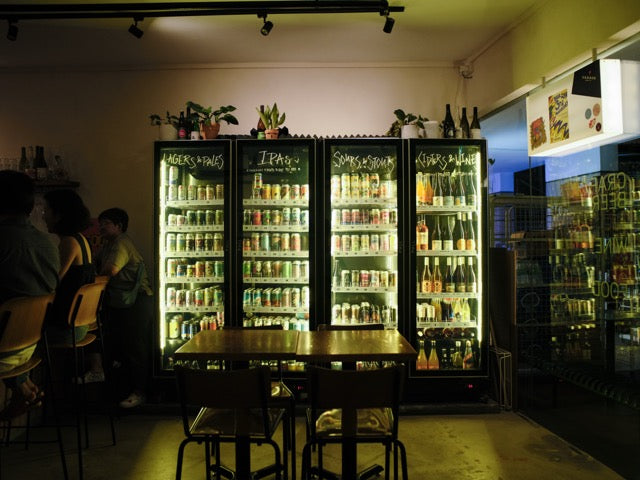With new craft beer bars popping up seemingly everywhere, it looks like the trend is making a post-pandemic comeback. Suddenly, we all have that one friend who’s really got into craft beers and insists that next catch up session has to be at one of those enigmatic taprooms. Maybe you’ve never had much interest in beers at all - but you’ve walked into a bottle shop once or browsed the occasional display at a supermarket. The colourful cans are attractive, sure - but perhaps you don’t know what any of the words on the cans mean, and what the heck is a “hazy beer”?
Fret not - here’s a quick guide into beer styles, and how to find the perfect brew for you.
All You Need to Know about Craft Beer Styles
We’ve all heard the words “lager” and “ales” thrown around in reference to beers, but what’s actually the difference? Are ales beers? What’s the difference between a fruit beer and a sour? What does IPA even stand for?
The quick answer to the first couple questions is that yes - lagers, ales, and stouts are all style categories under the big umbrella of beers. The style of a beer describes how it’s balanced (on the sweet/malty to bitter/hoppy scale) and how light or heavy it is (referring to the body and alcohol content). Knowing this will help you identify the type of beer you’d most likely enjoy of the myriad of options.
Lagers
This is the style you’re probably most familiar with. Most commercial beers are made in this style and are widely popular for their neutral, easy-drinking character. But what you might not know is the wide variety within this category alone.
Craft brewers experiment more with the different styles within this category so you get brews that are influenced from the more traditional Southern German Pilsners or Munich Helles that tend to be more malt-focused, to lagers brewed for the Asian market - these tend to use rice alongside pale malts for a lighter body and more crisp finish.
If you’re unsure about where to begin, it’s best to start here to tease out the more subtle nuances of what you might be into.
IPAs
Okay real quick, IPA stands for India Pale Ale, and no, they’re not all from India. It’s a style that was popularised back when the British were travelling to India (iykyk) and had to use large amounts of hops (a little green plant used to give beer flavour, and bitterness to balance malt sweetness) to preserve beers for the long voyage since refrigeration systems weren’t invented yet. Paler malts came into popular use in these beers because of the hot weather as well.
Today, there’s an extremely wide array of different IPAs as hop growers develop more varieties of hops, and brewers experiment with those alongside changing up the malts they use. The two main groups of IPAs can roughly be classified as West Coast-style or American IPAs, that are known for their piney, resinous, bright citrus character and higher perceived bitterness; and Hazy, or New England-style IPAs, that tend to be more fruity or floral, and have a juicy character. Side note: the “hazy” label refers to the cloudy appearance of these beers that arises from the use of a different variety of yeast.
There tends to be a slight misconception that IPAs are inherently unpleasantly bitter, when really, they should be known for being extremely flavourful because that is their main feature. A properly balanced IPA can be an interesting way to take your beer drinking experience to the next level.
Pale Ales
Intrigued by the flavour burst that an IPA can bring but still not sure because of the higher ABV (Alcohol By Volume) or the bitterness still stretches the limits of your comfort zone too far? Perhaps the gentler balance of a pale ale would be more to your taste. It’s the happy middle between the simplicity of a lager, and the smack-you-in-the-face quality of IPAs. These brews are built to be well-balanced and for easy-drinking, paired with the interest of a slightly more robust hop profile than lagers.
And while you’re here, why not try a session IPA for an extra kick? These are made to have the burst of hoppiness you get from an IPA, but with lighter malts to make them very crushable, especially on a hot day.
Sour Beers
Traditional sour beers such as Berliner Weisse or Flander’s Red Ales look very different from what we see in the craft beer market today. Overall, there are several ways of producing sours, and they make use of the addition of bacterias such as lactobacillus (same stuff they use in yoghurts) or brettanomyces (similar strains are used for champagne) in the fermentation process.
Modern sours often make use of copious amounts of fruit, and sometimes other ingredients like lactose and chocolate (the possibilities are endless with these), but make no mistake, they’re definitely still beers. Though not tasting like beers we’re most familiar with, or perhaps because of that, this style is finding growing popularity with those looking for novelty on the scene.
In fact, there is a growing presence of breweries specialising in sour beers to make what we refer to as smoothie/pastry sours. They’re perfect if you’ve got a sweet tooth.
Stouts
The dark colour of stouts is generally due to the amount of roasting that the malts used to produce them go through - think of the deepening colour of a slice of bread as you toast it for longer periods of time. Additionally, you’d probably notice more roasted coffee or chocolate-like notes in these darker brews.
We all know and love a good ol’ pint of Guinness. However, this familiarity with just Irish Stouts might bring some confusion regarding the many variations found within the craft versions.
The stouts of mass popularity tend to be those with lighter bodies and a drier finish than their counterparts. Other varieties include brews that use oats or milk sugars, that give a creamy quality to the brews; or they may be barrel-aged (that means that after brewing, the beer is allowed to sit in casks that were used to hold spirits like rums or whiskeys).
For those seeking something on the darker, sweeter side, stouts are the ideal treat.
How to Pick the Right Beer for You
Now that you have an arsenal of information on the different beer styles, how do you decide what you might like? Within each category, there are so many variations on each style, and furthermore, countless options of each of those variations. You could say you’re spoilt for choice.
So, here are a few points to consider to guide you in making that decision. We all know whether you enjoy the drink you’re having can influence how good of a night, or day (we don’t judge) you’ll have.
Consider the Weather
The same way you’d like a warm bowl of soupy noodles on a rainy day, or an ice-cold soda on a sweltering afternoon, your experience with drinking a beer may be affected by the weather.
When it’s hot out, consider a brew made with paler malts with a light body and crisp finish. Bitter beers may actually be very pleasant in this weather as well given that it provides a refreshing quality to the brew. Examples would be pilsners in the lager category, a session IPA, or a west coast-style pale ale.
On cloudy or rainy days where there’s a bit of a chill in the air, you may want to consider a more malt forward brew like a Belgian-style ale, or a darker ale like a porter or a stout. The smooth, creamy quality of these brews is most likely to hit the spot when you’re craving a cosy afternoon indoors.
Think About the Food You’ve Had
We may be familiar with wine and food pairings, but beers can play a role in influencing or being influenced by what you’ve had or are having in your meal.
Just like how white wines go great with white meats like fish or chicken, hazy beers with floral, stone fruit or pome fruit notes can be a great pairing.
If you’ve had a particularly heavy meal, a light brew with higher carbonation may be the palate cleanser you need.
Or, if you’re feeling like a dessert, a thick, fruity sour, or a decadent chocolate stout might be what you’re looking for.
The Quick Pick Route
Run these three quick questions to help yourself out:
Am I looking for something lighter, or would I like something more punchy?
Do I prefer sweet tropical, citrus flavours, or bitter floral, herbal flavours?
Am I planning to have a few beers, or just the one? (When/if you have several beers in the right order, you can allow your palate to build up to bigger beers from more approachable ones and enjoy a better drinking experience.)
Check With the Staff
If you’re still stuck in indecision, never hesitate to give the staff pointers on what you’re looking for and ask for samplers (if you’re looking at a list of beers on tap) to assist you along.
Your Craft Beer Journey is Your Own
At the end of the day, craft beer is a vast landscape to explore. Perhaps you’ve decided that you’re not ready to tackle the world of IPAs, and that’s okay! There are plenty of other styles that might excite your tastebuds and pique your interest more. That doesn’t mean you appreciate the carefully crafted brews any less than a hophead. Like any other realm of interest you might invest in, moving at your own pace and exploring in a way that brings you the most enjoyment should be the guiding light to your journey ahead.
We'll look forward to accompanying you as you expand your palate with our selection at the taproom. Cheers!









